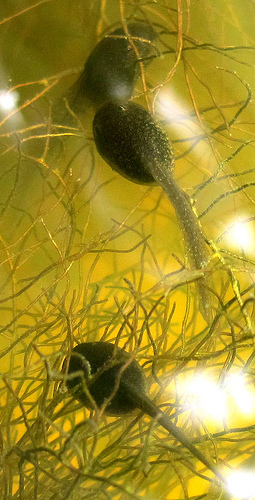Overview
 The common frog, in spite of its name, is not common in many areas of Britain these days. In the intensively farmed countryside the frog has almost completely disappeared. Agricultural sprays, draining wetland habitats and filling-in small ponds that the frogs use as breeding sites, are the main reasons for the frogs’ decline.
The common frog, in spite of its name, is not common in many areas of Britain these days. In the intensively farmed countryside the frog has almost completely disappeared. Agricultural sprays, draining wetland habitats and filling-in small ponds that the frogs use as breeding sites, are the main reasons for the frogs’ decline.
Whilst it can be great fun to collect frog spawn in the spring, we wouldn't recommend it, as moving them from one place to another can spread diseases such as chytrids. Amphibians will generally find their way over time to suitable ponds, so the most important thing is to create pond habitats that they will be attracted to.
Guide
The following points are a guide on how to care for frog spawn and tadpoles.
1. Unpolluted pond water or rain water are ideal for frog spawn. Do not put frog spawn into tap water unless it has been allowed to stand for about three days. The water should be changed at least twice a week to avoid contamination.
2. Water temperature is very important, between 15°C and 20°C is the best temperature for tadpole development. Pollution can be a problem if the temperature rises above 20°C.
3. Never put frog spawn or tadpoles from water at one temperature straight into water at a different temperature. Death is likely to result! If you want to transfer frog spawn from a small container into a larger container, a pond for example, then stand the small container complete with frog spawn inside the pond. When both water temperatures are the same, which may take a few hours, then at last you can release the frog spawn into the pond. It is most important that the frog spawn or tadpoles do not over-crowd the containers at any stage.
4. When the tadpoles first hatch, a quantity of fresh pond weed at this stage is very important; partly as food and partly as support for young tadpoles. Nettle powder, made from dried stinging nettle leaves, can also be fed to the young tadpoles..

5. When tadpoles reach the leg stage they become carnivorous (meat eaters). They will eat each other unless you provide meat for them. Small pieces of liver should be carefully suspended on a piece of string into the water.
The meat should be changed every day to avoid polluting the water. Fish fry food for livebearers, available from aquarium and pet shops, can also be fed sparingly to the tadpoles at this stage.
6. When tadpoles reach the leg stage, make sure that stones are placed at the edge of the pond in such a way that the young frogs, when they develop, can climb clear of the water to breathe.
8. The whole process of change - from tadpole to young frog – takes about 12 weeks.
Credits
Image: Frogspawn and Tadpoles by Oaktor Photography
Further Information
Frog Life - Froglife is a national wildlife charity committed to the conservation of amphibians and reptiles
Froglife.org
Amphibian and Reptile Conservation
www.arc-trust.org
The British Herpetological Society - The Young Herpetologists Club
www.thebhs.org/YHC.html
 The common frog, in spite of its name, is not common in many areas of Britain these days. In the intensively farmed countryside the frog has almost completely disappeared. Agricultural sprays, draining wetland habitats and filling-in small ponds that the frogs use as breeding sites, are the main reasons for the frogs’ decline.
The common frog, in spite of its name, is not common in many areas of Britain these days. In the intensively farmed countryside the frog has almost completely disappeared. Agricultural sprays, draining wetland habitats and filling-in small ponds that the frogs use as breeding sites, are the main reasons for the frogs’ decline.

